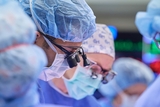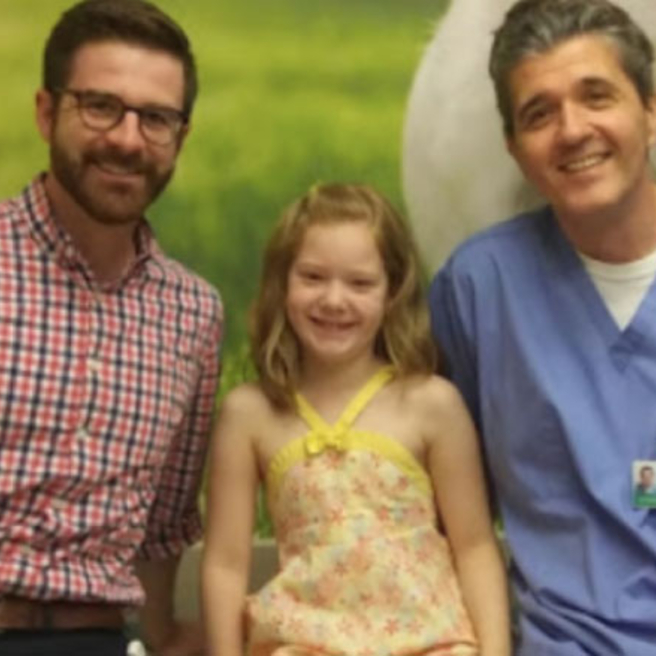What are choledochal cysts?
Choledochal cysts are a congenital or acquired condition that slows the flow of bile carried from the liver to the small intestines. These cysts enlarge the ducts that transport bile between the liver, where bile is produced, and the small intestine. They can occur in the bile ducts, either inside or outside the liver. When choledochal cysts are present, they can cause the bile system to “back up” leading to a range of health issues for your child.
Most choledochal cysts (approximately two thirds) are diagnosed before a child reaches 10 years of age. Choledochal cysts occur in only about 1 in 100,000 – 150,000 live births in developed societies, and are diagnosed more often in girls than boys.
Signs and symptoms of choledochal cysts
Children with a choledochal cysts typically present with symptoms such as:
- Pain
- Jaundice
- Nausea
- Abdominal mass
- Pancreatitis
Diagnosing choledochal cysts
Choledochal cysts are most commonly diagnosed by ultrasound. In rare cases the cysts may be diagnosed before birth on a prenatal ultrasound. Other imaging tests that may be used in the diagnosis of a choledochal cyst include CT scans (computerized tomography scan), magnetic resonance cholangiopancreatography (MRCP) or endoscopic retrograde cholangiopancreatography (ERCP).
Choledochal cysts are typically diagnosed as one of several types:
- Type I: Cyst of the bile duct. This is the most common type of choledochal cyst, accounting for about half of all choledochal cysts.
- Type II: Pouching or sac on the bile duct.
- Type III: Cyst within the wall of the duodenum (where the duct connects to the liver) or pancreas.
- Type IV: A Type I cyst that extends into the liver along the bile ducts.
- Type V: Multiple cysts along the bile duct inside the liver, also known as Caroli’s Disease.
If left untreated, complications of choledochal cysts may include:
- Infection
- Jaundice
- Pancreatitis
- Gallstones and sludge in the bile duct and gallbladder
- Gastrointestinal (GI) obstruction
- Cirrhosis of the liver
- Malignancy, or the development of bile duct cancer (cholangiocarcinoma)
Surgical treatment for choledochal cysts
Choledochal cysts are typically treated surgically, either by an open surgical procedure (using one incision) or laparoscopically, where small incisions and a camera are used to guide the surgeon. Both procedures are performed in the operating room under general anesthesia. In both types of surgery for choledochal cysts, the cyst is removed and often the system of bile ducts are reconstructed or repaired using a section of intestine.
Laparoscopy, a minimally invasive surgical technique, may be used to remove your child’s choledochal cyst. The laparoscopic removal of a choledochal cyst begins with the surgeon making small incisions in your child’s abdomen.
In one incision (in the belly button) a small scope (or camera) is placed to allow the surgeon to see all of the abdominal organs. Small surgical tools are placed in the other incisions. The abdomen is filled with gas during the procedure to allow the surgeon to see easily.
The surgeon uses these tools to remove the cyst through the small incision in your child’s belly button.
The biliary system is then reconstructed using a section of the intestine called the duodenum (this procedure is called a hepaticoduodenostomy) or by a section of the intestine called the jejunum (called a Roux-en-Y hepaticojejunostomy).
With open an open surgical procedure the surgeon will make one incision in the right upper abdomen.
DERMABOND (skin glue) will cover the incisions, with dissolvable sutures underneath the skin. These sutures will not need to be removed, and the glue will allow for the incisions to get wet.
Follow-up care after surgery for choledochal cysts
After the operation, your child will receive IV fluids until they are able to drink clear liquids without nausea or vomiting, and will slowly advance to a regular diet. Your child may be given antibiotics through an IV to prevent infection. Pain medication will also be given as needed.
Following surgery, your child will need to get out of bed, walk and move around. This helps to relieve gas pain common after this type of surgery. It also helps your child heal faster.
If the procedure was done laparoscopically, your child will go home in approximately 3 to 5 days. If your child had an open excision of a choledochal cyst, they will remain hospitalized for a few days longer to ensure a full recovery.
Your child’s surgeon and care team will discuss the recovery process with your family, including potential risks and complications to watch for:
- Bile leak
- Redness or swelling called cholangitis that could indicate infection
- Bleeding
- Strictures (narrowing of the bile duct)
- Wound infection
- Stone formation in the bile ducts (intrahepatic biliary stone)
While choledochal cyst removal will reduce the risk of bile duct cancer (cholangiocarcinoma), your child will be at higher risk of developing cancer in the remaining bile ducts inside the liver compared to the general population. There is also risk of narrowing in the reconstructed bile duct, which can lead to complications such as cholangitis, intrahepatic calculi (stones) and pancreatitis.
Continued yearly follow-ups with a gastroenterologist or your pediatric surgeon is recommended to monitor for these possible complications. Your child may require ongoing blood work and imaging at regular intervals.
When to call your doctor
Please call the Division of Pediatric General, Thoracic and Fetal Surgery at 215-590-2730 if your child has any of the following symptoms in the days following surgery:
- Fever (101.5 degrees or higher)
- Increased pain
- Any signs of infection, including redness, swelling and/or drainage at incision site(s)
- Jaundice
- Any further questions or concerns
Once home, your child can gradually return to his normal activities as tolerated.

Why choose CHOP for your child's surgery
If your child needs surgery, you want to know their care is in the hands of the best, most compassionate team. CHOP's world-class pediatric surgeons and experienced staff are here for you.

Preparing for surgery
Find tips to prepare for your preoperative visit with CHOP’s pediatric general surgeons, and resources to help prepare your child for surgery.
Resources to help
Division of Pediatric General, Thoracic and Fetal Surgery Resources
We have created resources to help you find answers to your questions and feel confident with the care you are providing your child.

